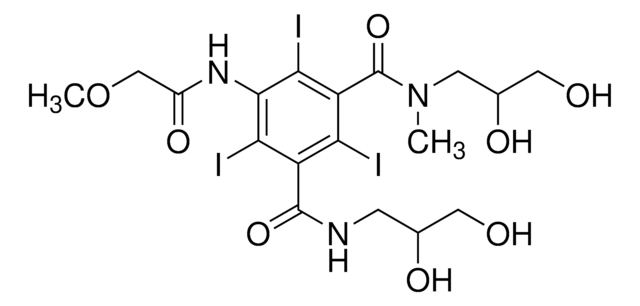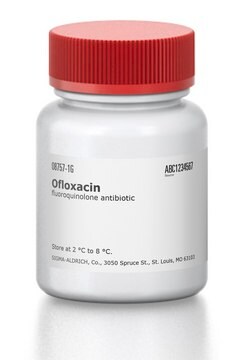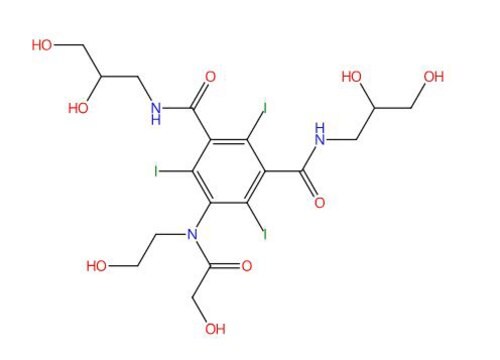Y0001020
Iopromide
European Pharmacopoeia (EP) Reference Standard
About This Item
Productos recomendados
grado
pharmaceutical primary standard
familia API
iopromide
fabricante / nombre comercial
EDQM
aplicaciones
pharmaceutical (small molecule)
Formato
neat
temp. de almacenamiento
2-8°C
cadena SMILES
O=C(N(C)CC(O)CO)C1=C(I)C(NC(COC)=O)=C(I)C(C(NCC(CO)O)=O)=C1I
InChI
1S/C18H24I3N3O8/c1-24(4-9(28)6-26)18(31)12-13(19)11(17(30)22-3-8(27)5-25)14(20)16(15(12)21)23-10(29)7-32-2/h8-9,25-28H,3-7H2,1-2H3,(H,22,30)(H,23,29)
Clave InChI
DGAIEPBNLOQYER-UHFFFAOYSA-N
¿Está buscando productos similares? Visita Guía de comparación de productos
Descripción general
For further information and support please go to the website of the issuing Pharmacopoeia.
Aplicación
Envase
Otras notas
Producto relacionado
Palabra de señalización
Warning
Frases de peligro
Consejos de prudencia
Clasificaciones de peligro
Aquatic Acute 1 - Aquatic Chronic 1
Código de clase de almacenamiento
11 - Combustible Solids
Clase de riesgo para el agua (WGK)
WGK 3
Punto de inflamabilidad (°F)
Not applicable
Punto de inflamabilidad (°C)
Not applicable
Elija entre una de las versiones más recientes:
Certificados de análisis (COA)
Lo sentimos, en este momento no disponemos de COAs para este producto en línea.
Si necesita más asistencia, póngase en contacto con Atención al cliente
¿Ya tiene este producto?
Encuentre la documentación para los productos que ha comprado recientemente en la Biblioteca de documentos.
Nuestro equipo de científicos tiene experiencia en todas las áreas de investigación: Ciencias de la vida, Ciencia de los materiales, Síntesis química, Cromatografía, Analítica y muchas otras.
Póngase en contacto con el Servicio técnico





